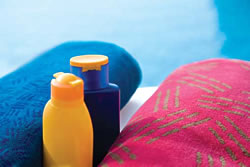HEALTH - HEALTHY & HAPPY
Beauty Inside & Out
Summertime - and the Skin Protection is Easy
July, 2007 - Issue #33
 |
Indeed, overexposure to ultraviolet rays actually causes oxidative damage and can alter the skin's DNA cellular structure, creating highly-toxic molecules known as free radicals. The end result may include leathery premature aging and wrinkles, skin cancer, cataracts and more.
For board certified plastic surgeon Dr. Edward Pechter and his fellow plastic surgery and dermatology colleagues, a common goal shared lies in preventing skin damage, and with good reason.
"Plastic surgeons have a great interest in preventing skin damage because we regularly repair the destruction caused by the sun's ultraviolet rays, including extreme cases where we reconstruct areas of the nose and ear after the ravages of skin cancer," said Dr. Pechter, a member of The American Society for Aesthetic Plastic Surgery and an assistant clinical professor of plastic surgery at UCLA.
Pechter, whose office is in Valencia, informs us that prevention of skin cancer is vital; within the United States each year nearly 1.3 million people are diagnosed with non-melanoma skin cancer and 50,000 new cases of melanoma.
Whereas non-melanoma skin cancers are the most common form of the skin cancer (and are about 95 percent curable), melanoma is the most deadly type (and accounts for 79 percent of all skin cancer deaths).
Sun Safety 101
| "It's estimated that 80 percent of SUN DAMAGE occurs before the age of 20." |
"Nowadays you are never too young to get skin cancer. In fact there have been many reports of kids getting skin cancer," Raskin said.
A worrisome finding corroborating Raskin's news: In recent years, skin cancer diagnoses among 16 to 24 year olds have risen 10 fold! This is thought to be largely due to tanning bed use.
To help prevent premature aging and skin cancer from sun exposure, here are some cool tips from the professionals.
Sunscreen
Wear sunscreen that's waterproof, sweat proof and PABA-free (note: PABA, para-aminobenzoic acid, widely used as a UV filter in sunscreens, has been determined to increase formation of a particular DNA defect in human cells, thus increasing risk for skin cancer in people who lack the mechanisms to repair these cellular defects.). Make sure your sunscreen has a sun protection factor (SPF) of at least 15 and is broad-spectrum, containing both zinc oxide (7 to 9 percent) and titanium oxide. (Raskin notes that Parsol 1989, a main sunscreen ingredient for years, protects well but breaks down quickly so you lose the protection faster. Neutrogena's Helioplex sunscreen contains a molecule similar to Parsol 1989 but it's supposed to remain stable and not break down.) Remember that SPF numbers can be misleading: they reflect how long it will take for your skin to get red if using that sunscreen. A sunscreen with an SPF 45 along with 9 percent zinc will protect you better than many of the SPF 60 sunscreens found in sto
res. For maximum benefits, sunscreen must be applied one hour prior to sun exposure. Because most don't contain these ingredients, sunscreens in makeup or moisturizers do not provide adequate protection but are a good addition to your regimen. If you are in the sun a lot, then reapply sunscreen every two hours. If swimming or in the water, reapply every hour. Be vigilant in applying sunscreen on children's skin - it's estimated that 80 percent of sun damage occurs before the age of 20.
 |
Avoid prolonged sun exposure, especially between 10 a.m. and 4 p.m. when the sun is strongest and can do the most damage to skin. Remember that ultraviolet rays pass through water and reflect on sand. Also, keep in mind that the higher the UV index, the shorter the time for skin damage to occur. Check the UV index in our area by going online to www.epa.gov/sunwise.
What to Wear
Apply lip balm with at least a SPF of 15. Wear a hat, sunglasses and protective clothing when spending long periods of time in the sun. Solumbra protective clothing has an SPF of 30. The fabric is lightweight and comfortable in hot weather.
Interactions
Remember that some medications (certain antibiotics, birth control pills, etc.) and antibacterial agents in soaps and creams may make your skin more susceptible to burning. Some perfumes and aftershaves may have a similar effect.
Beyond protecting yourself from the sun and preventing serious sun damage, there is much you can do to help rejuvenate and improve your skin.
"You may also wish to add a topical antioxidant to your skin care routine," said Shanell Roberts, a licensed esthetician and operating room technician at Pechter's office. "They neutralize harmful free radicals. SkinCeuticals offers a great line of antioxidant serums, which can add eight times the photo protection when combined with a sunscreen."
Found at Pechter's practice, the Skin Obsession products include a terrific "health and hydration" facial (which helps bind moisture to the skin that was lost through perspiration and summer activities), and a refreshing pineapple/papaya glycolic peel, said Roberts, who specializes in facials, chemical peels and microdermabrasion.
Raskin's office also offers numerous skin-renewing treatments and a variety of sunscreens and other cosmetic products.
| "Some medications and antibacterial agents in soaps and creams may make your skin more susceptible to BURNING." |
"While natural elements can wreak havoc on one's skin, they also repair and nurture it," says Gail White of Saje Natural Wellness in Valencia, which offers a wide range of natural skin care solutions for the face and body.
For example, if you have sunburned skin, White suggests using lavender oil. "Best known for its sedative qualities, lavender oil also heals sunburn and reduces potential blistering from excessive sun," she said.
For dry or damaged skin, rose oil is said to have powerful healing properties. "Often used in quality skin care products, rose oil has a reputation for enhancing beauty," White commented.
Want swimsuit-ready legs? Kelp sea salt, grapefruit oil and juniper berry oil are just a few natural ingredients to smooth out cellulite, while hemp seed oil and olive oil combined with lavender and Roman chamomile heal and deeply moisturize freshly shaved or waxed skin, White stated.
"Incorporating wholesome products into one's daily skincare regimen truly can make a difference in improving the effects of the sun," declared Dr. Chris Towery of FACES Cosmetic Laser Center on Lyons Avenue in Santa Clarita.
At Faces, Towery and his staff offer skincare products that are natural and easy to use, including cleaners and antioxidants.
"Our products help protect the skin from the sun as well as keeping it clean and looking young," said Towery, a Ph.D. and nurse practitioner. "Our moisturizer Refine is a prescription-strength formula with an SPF of 30. It combines the most potent antioxidants available that combats the harmful effects of the sun."
The "Skin-ny" on Summer and Skin
Well, there it is, helpful information from some of our valley's most reputable physicians and skincare professionals on how to protect your epidermis - particularly during the long, hot summer. Hopefully by applying what you've read, you'll "save your own skin" and love the results you see.
--------------------------------------------------------------
Melanoma Information You can "Apply"
As with any health risk, prevention and early detection are our mightiest weapons. This applies to timely identification of all skin cancers, but is especially crucial for detecting melanoma.
"Melanoma is the most serious form of skin cancer, however, if it is recognized and treated early, it is nearly 100 percent curable," said board certified dermatologist Dr. Bernard I. Raskin of Valencia.
If not treated promptly and correctly, the physician warns, the cancer can advance and spread to other parts of the body, where it becomes hard to treat and can be fatal.
In recent years, melanoma diagnoses have skyrocketed across the age charts. According to the American Academy of Dermatology, melanoma diagnoses have increased 690 percent from 1950 to 2001, and the overall mortality rate has increased 165 percent during this same period.
Melanoma is currently the second most common cancer among 20- to 29-year-old women, yet many continue to bake in the sun for hours in search of the "perfect tan."
The American Cancer Society estimates that there will be 59,940 new cases of melanoma in 2007, with 8,110 deaths.
Melanoma originates in the cell that produces the pigment melanin. These cells are heavily concentrated in most moles. The majority of melanomas, therefore, are black or brown. Melanomas occasionally stop producing pigment, and when that happens, the melanomas may no longer be dark, but are skin-colored: pink, red or purple.
While anyone can get melanoma, certain people are more susceptible, such as those who are fair skinned, over 40 and were sun-lovers when they were young, young people who expose themselves excessively to the sun and/or tanning beds, those with a family history of melanoma, people with weakened immune systems and those with abundant freckles (more than 100).
Dr. Raskin recommends patients see their dermatologist annually for "body checks." In between physician checks, regular self-examinations should be performed every month or two.
Here is an overview of melanoma warning signs.
Asymmetry: If you draw a line through the mole, the two halves will not match, meaning it is asymmetrical.
Border: The borders of an early melanoma tend to be uneven. The edges may be scalloped or notched.
Color: Having a variety of colors is another warning signal. A number of different shades of brown, tan or black could appear. A melanoma may also become red, white or blue.
Diameter: Melanomas usually are larger in diameter than the size of the eraser on your pencil (1/4 inch or 6 mm), but they may sometimes be smaller when first detected.
Evolving: Any change in size, shape, color, elevation or another trait, or any new symptom such as bleeding, itching or crusting, points to danger.
Prompt medical action is a must if you discover anything on your skin that raises alarm!
|
||||||||||||||||||||||||||||




